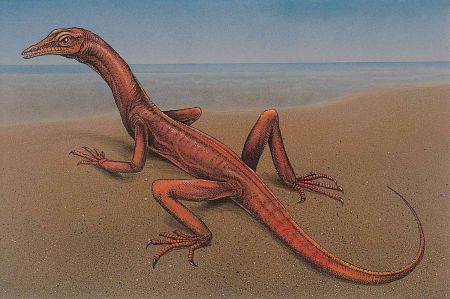Reptiles
Most spectacular of the fossils found at Monte San Giorgio are the reptiles represented by approximately 25 species of mostly marine taxa. These show different degrees of adaptation to aquatic life.
The eosauropterygia with their characteristic 'paddle'-shaped limbs stand out. Members include Ceresiosaurus, measuring up to 3 metres in length, and Neusticosaurus (30–100 cm) on which Ceresiosaurus fed. Other famous representatives of this group are Serpianosaurus, Lariosaurus, and Nothosaurus. The latter, having powerful teeth and a length of almost 4 metres, was a predator that was probably at the top of the food chain.
A large specimen of Ceresiosaurus together with seven small skeletons of Neusticosaurus from the lower Meride Limestone (length of the plate 2.5 m), © PIMUZ
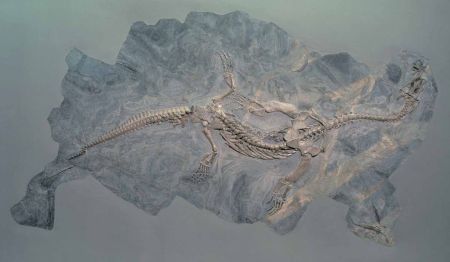
Better adapted to life in the sea were the ichthyosaurs. Equipped with a long beak, a vertical caudal fin and limbs transformed into efficient paddles, they were similar in appearance to dolphins today. The fossils collected most frequently belong to the basal ichthyosaur genus Mixosaurus that had an average length of one meter and fed mainly on squid (Phragmoteuthidae). Present but rare are the larger ichthyosaurs such as Cymbospondylus and Besanosarus, which grew to approximately 4 and 6 metres in length, respectively. Besanosaurus is the largest reptile found so far at Monte San Giorgio and was discovered in 1992 by the Museo Civico di Storia Naturale of Milan during a palaeontological excavation at Sasso Caldo in Italian territory.
Skeleton of two ichthyosaurs, Mixosaurus (above) and Besanosaurus (below), from the Besano Formation (length 2.5 m), © PIMUZ
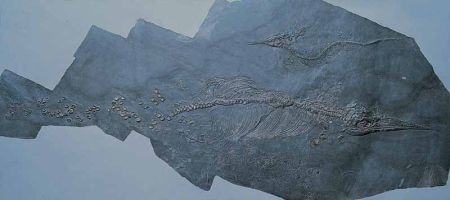
One of the more extraordinary marine reptiles was Tanystropheus, a protorosaur that could reach six metres total body length.Tanystropheus had a very long neck (almost like a giraffe) and mainly hunted squid.
Another peculier group of reptiles were the placodonts, such as Paraplacodus or Cyamodus. Their flat, oval teeth were highly specialised for crushing the shells of marine organisms, such as molluscs and crustaceans.
Skeleton of Paraplacodus broili of the Besano Formation, length 1.5 m, © PIMUZ
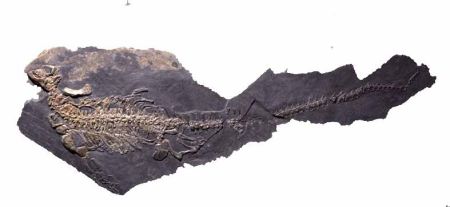
The thalattosaurs, which include Clarazia, Hescheleria, and Askeptosaurus, were another group of reptiles that fed on molluscs and crustaceans in addition to fish.
An Askeptosaurus of 2 m length hunting for fish in the sea of the Besano Formation, © PIMUZ / B. Scheffold 1991
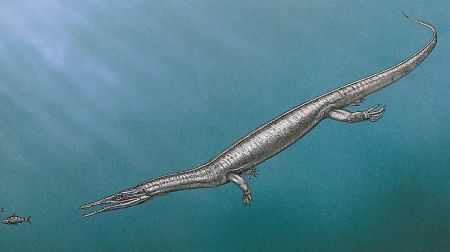
The nearby terrestrial environments were also inhabited by large reptiles. For example, Ticinosuchus, a member of the rauisuchians (archosaurs that include the ancestors of dinosaurs and crocodiles), was a predator capable of running fast despite measuring two and a half metres in body length.
Slightly disarticulated skeleton of the rauisuchian Ticinosuchus from the Besano Formation, length 2.50 m, © PIMUZ
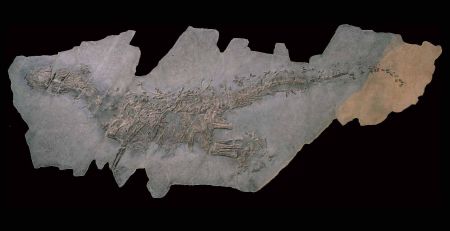
Life reconstruction of Ticinosuchus. This rauisuchian lived on the mainland and was probably dragged into the sea after death and transported out to the Besano Formation by storms and flood, © PIMUZ, model B. Scheffold
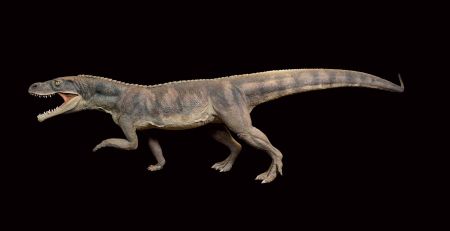
More modest in size was Macrocnemus, a small protorosaur approximately one metre in length with a slender neck living in coastal areas by the sea. It too was able to run fast, probably in an upright position on its long hind legs, with a gait similar to a modern-day large lizard.
Skeleton of the protorosaur Macrocnemus from the Meride Limestone (length 0.8 m), © PIMUZ
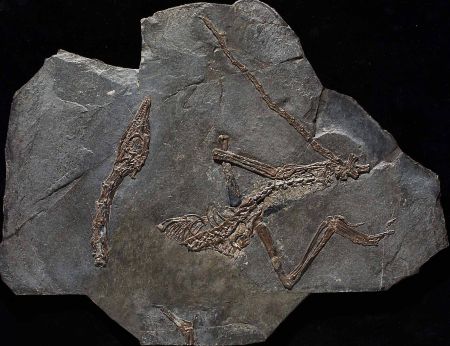
Life reconstruction of Macrocnemus on the beach. © PIMUZ / B. Scheffold 1991
